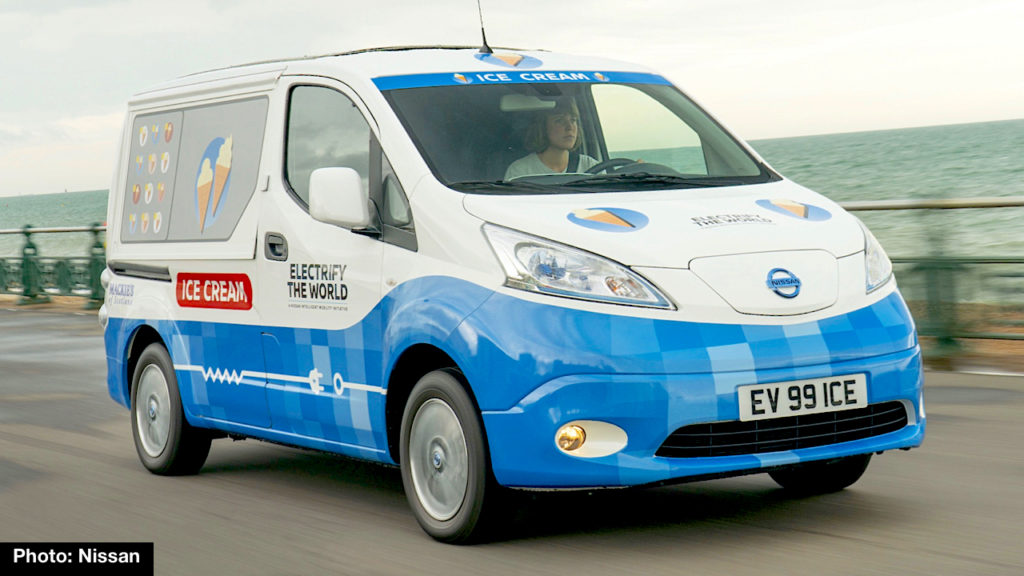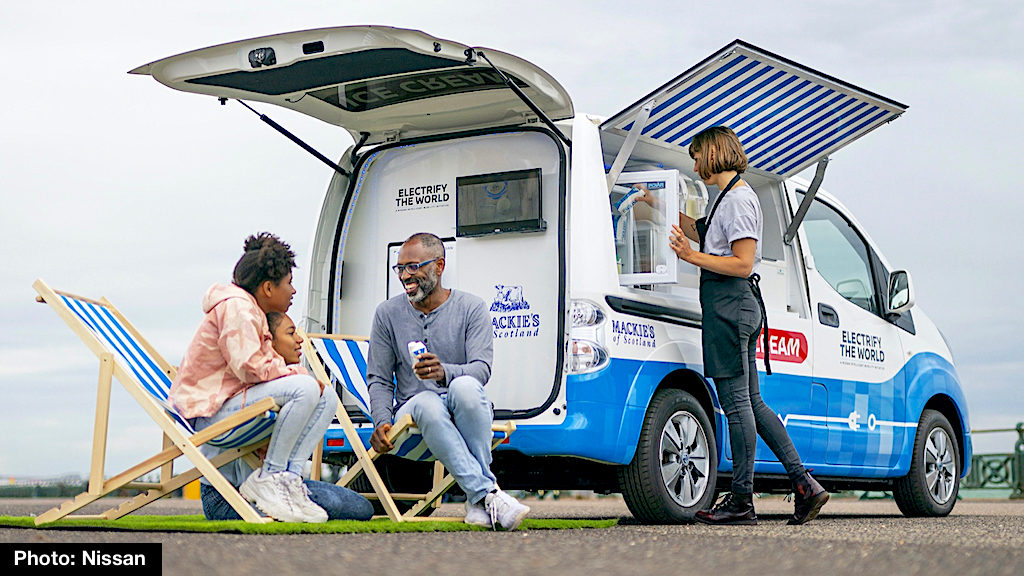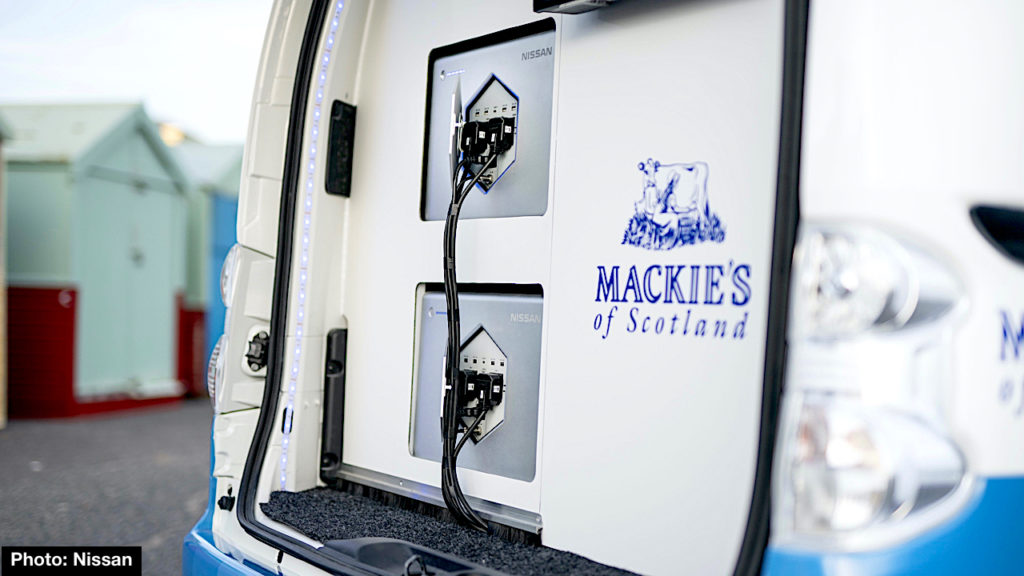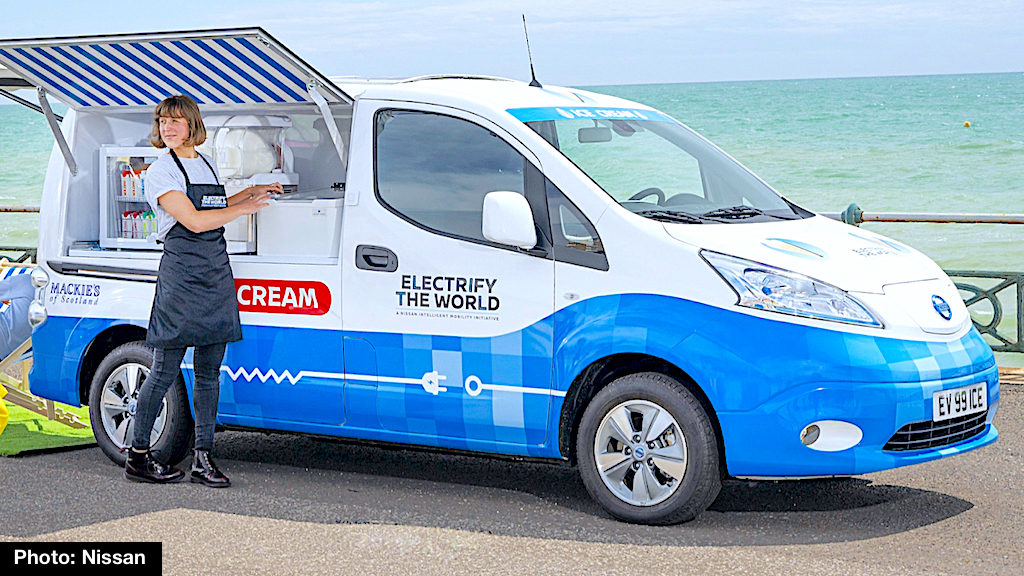By Steve & Tamami Laser
Nissan has sold more than 20,000 of the all-electric e-NV200 since the Barcelona-built van went on sale in Europe five years ago. The longer-range 40kW version introduced last year helped make it the “best-selling zero-emissions LCV” in 10 markets across Europe (according to Nissan) as more businesses look to electrify their fleets. So what do they do for an encore? Transform the e-NV200 into an ice cream van.
The cool new concept, created in partnership with Mackie’s of Scotland, made its debut during Clean Air Day in the UK on June 20. The ice cream producer powers its family owned dairy farm with renewable wind and solar energy. Thus the “Sky to Scoop” approach is said to remove carbon dependence “at every stage of the ice cream journey.”
As a “NICE (No Internal Combustion Engine) cream van,” the concept highlights the Nissan Electric Ecosystem, with its all-electric drivetrain, second-life battery storage, plus renewable solar energy generation.
While the 40kW battery is used to propel the van, the ice-cream gear, including a soft-serve machine, freezer drawer, and fridge for drinks, is powered by Nissan Energy ROAM. This new portable power pack employs lithium-ion batteries that have been recovered from Nissan’s first-generation LEAF (dating to 2010), showcasing sustainable second-life for the batteries.
Nissan says that most ice cream trucks, especially older ones, need to keep their diesel engines running to power the refrigeration unit. Some towns and cities in the UK are reportedly seeking to “ban” or “fine” these vehicles. Nissan’s e-NV200 ice cream van concept offers a method for operators to help reduce their carbon footprint.
Tricks and Treats of the e-NV200 Ice Cream Van
Nissan says that e-NV200 has an all-electric driving range of up to 124 miles (WLTP Combined)* between charges. Two Nissan Energy ROAM units have a combined storage capacity of 1.4kWh and can each output power up to 1kW. They can be recharged from a 230V main supply (recharge time estimated at 1 hour) or using the solar panels on the van’s roof (with full recharge estimated in 2 to 4 hours**).
Ice cream is served via a hatch that swings up from the side of the van. Customers can opt to pay for their treats using a “tap-to-pay” panel on the side of the vehicle. Instead of a loud “jingle” to attract customers, the van uses a smart button to generate a tweet of its exact location via a global addressing service.
With its V2G (Vehicle-to-Grid) charging, Nissan says e-NV200’s battery can store surplus energy from the national grid (such as renewable wind and solar energy) and provide it back to the grid when needed, helping to balance peaks in energy demand, and potentially providing EV owners with a source of income when the van is parked (during the winter).
Here’s the Scoop on Mackie’s of Scotland
After we finish posting this story, we’re headed to the store to get some ice cream. (And we wish we could buy Mackie’s.) The ice cream producer says it aims to be Britain’s “greenest company by becoming self-sufficient in energy and removing any dependence on fossil-fuels.”
For the e-NV200 concept, Mackie’s provided some of their Traditional mix for the soft-serve machine (their most popular flavor that’s said to be natural and creamy with no added vanilla), along with dairy ice cream for scooping from the freezer drawer.
* Figures shown for the UK market are for comparative purposes; only compare figures with vehicles tested to the same technical procedures. The electric range shown achieved using the new (WLTP) test procedure. Figures obtained after the battery was fully charged. Actual real world driving results may vary depending on factors such as the starting charge of the battery, accessories fitted after registration, weather conditions, driving styles and vehicle load.
** STC: Standard Test Conditions are defined as the solar irradiation of one kilowatt (kW) per square meter, a module temperature of 25 degrees Celsius and a solar irradiation angle of 45 degrees. Using a solar panel accessory, the charge time will depend on the solution used as well as the solar irradiation.
Note: The e-NV200 ice cream van is a concept vehicle
News source and photos courtesy of Nissan Motor (GB) Ltd.
Story (commentary) © 2019 CarNichiWa.com



